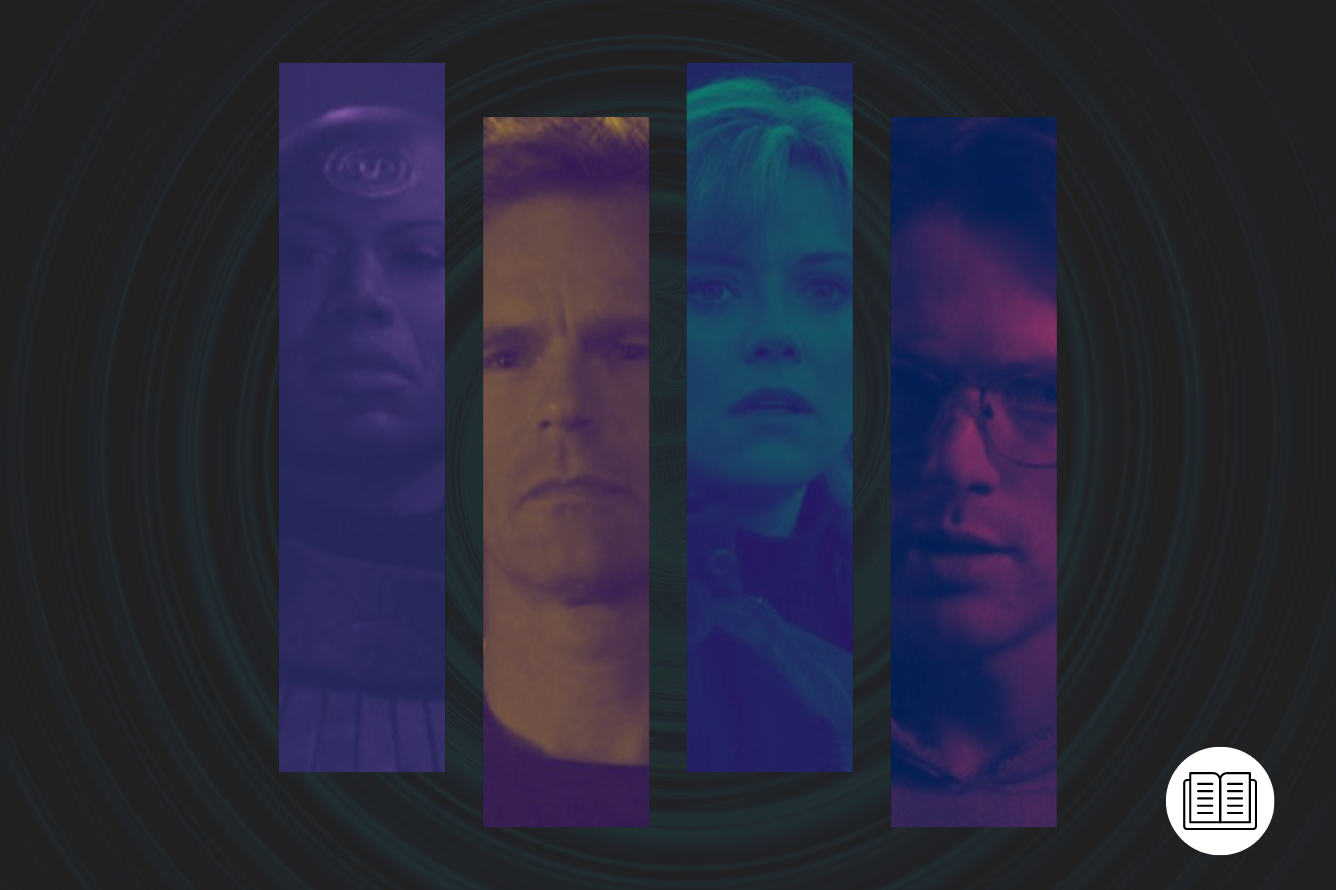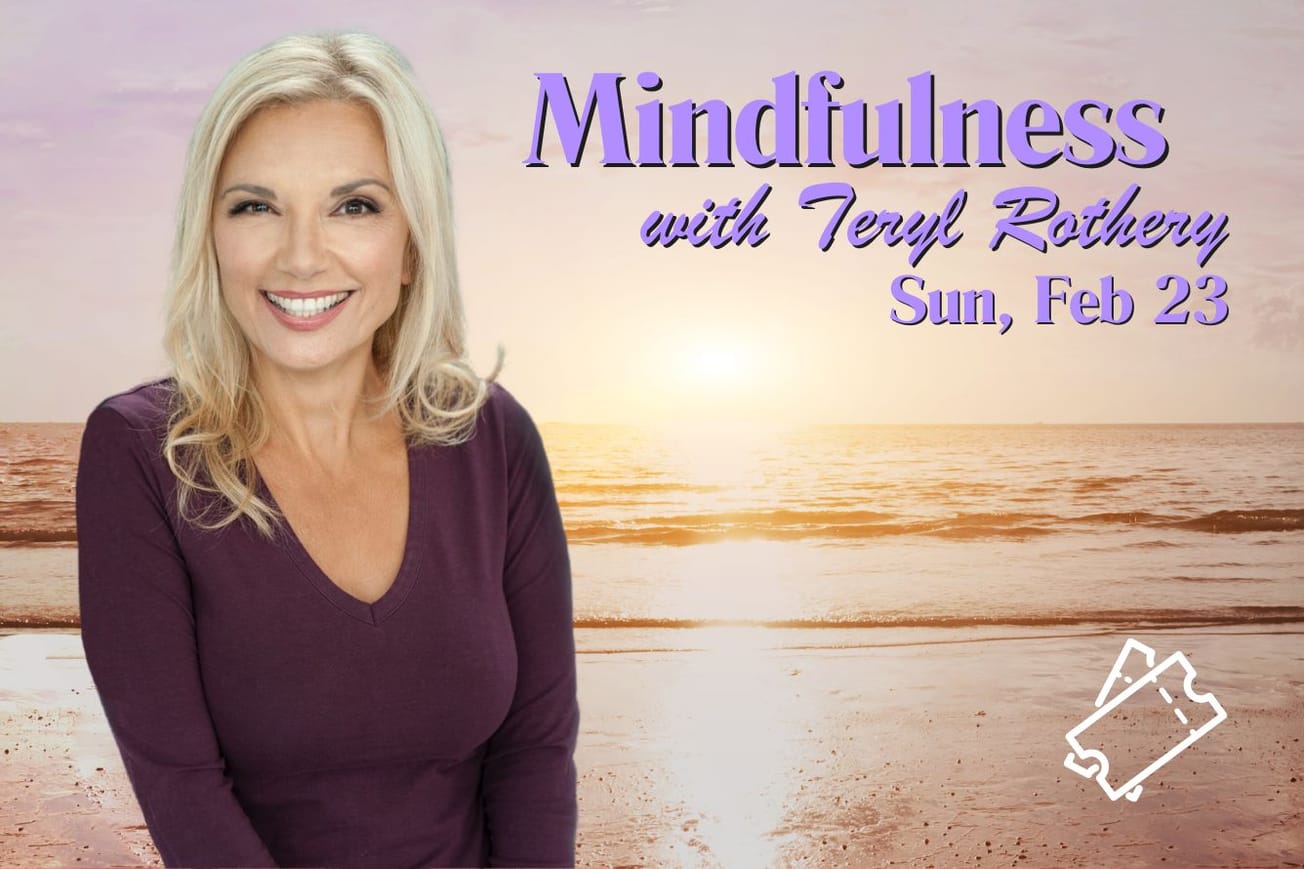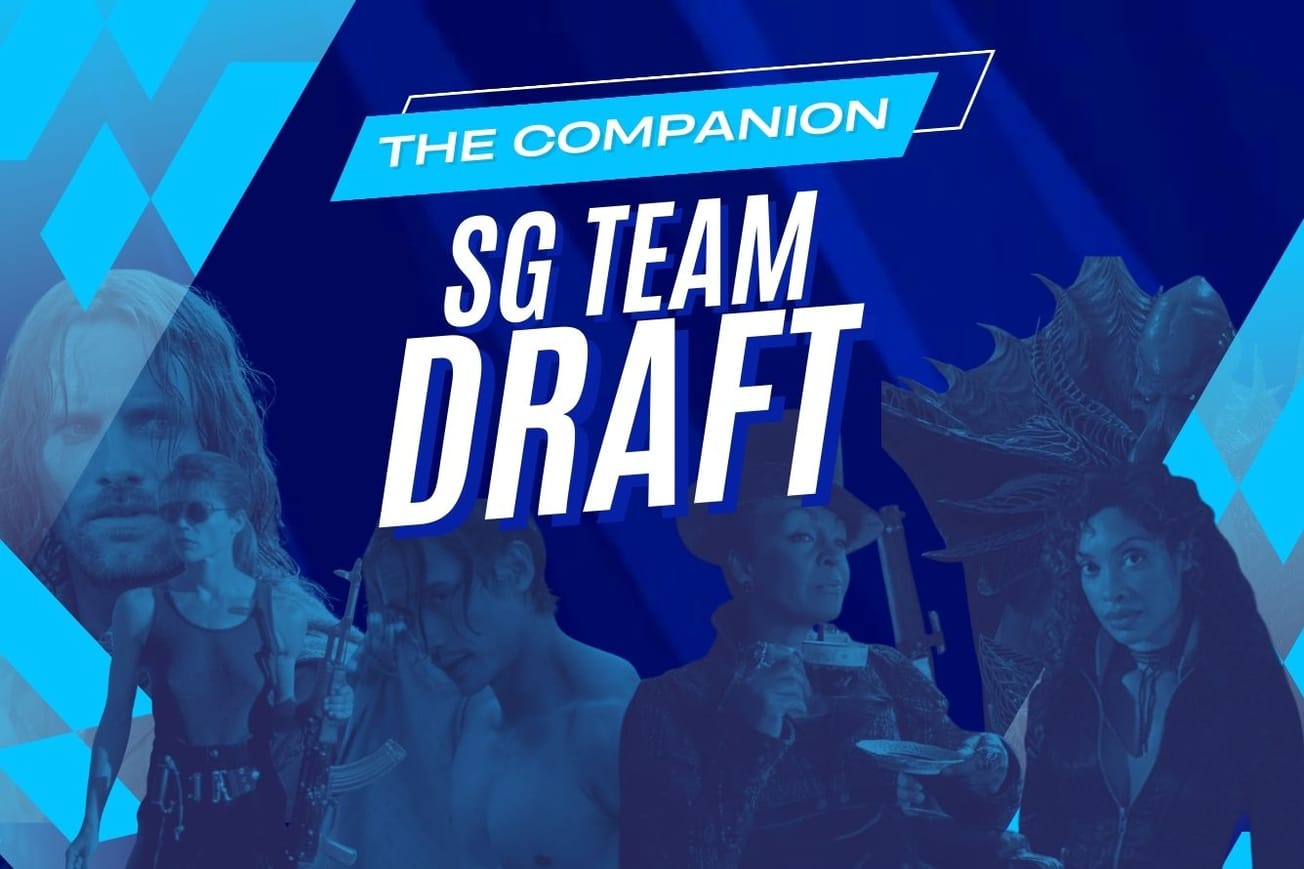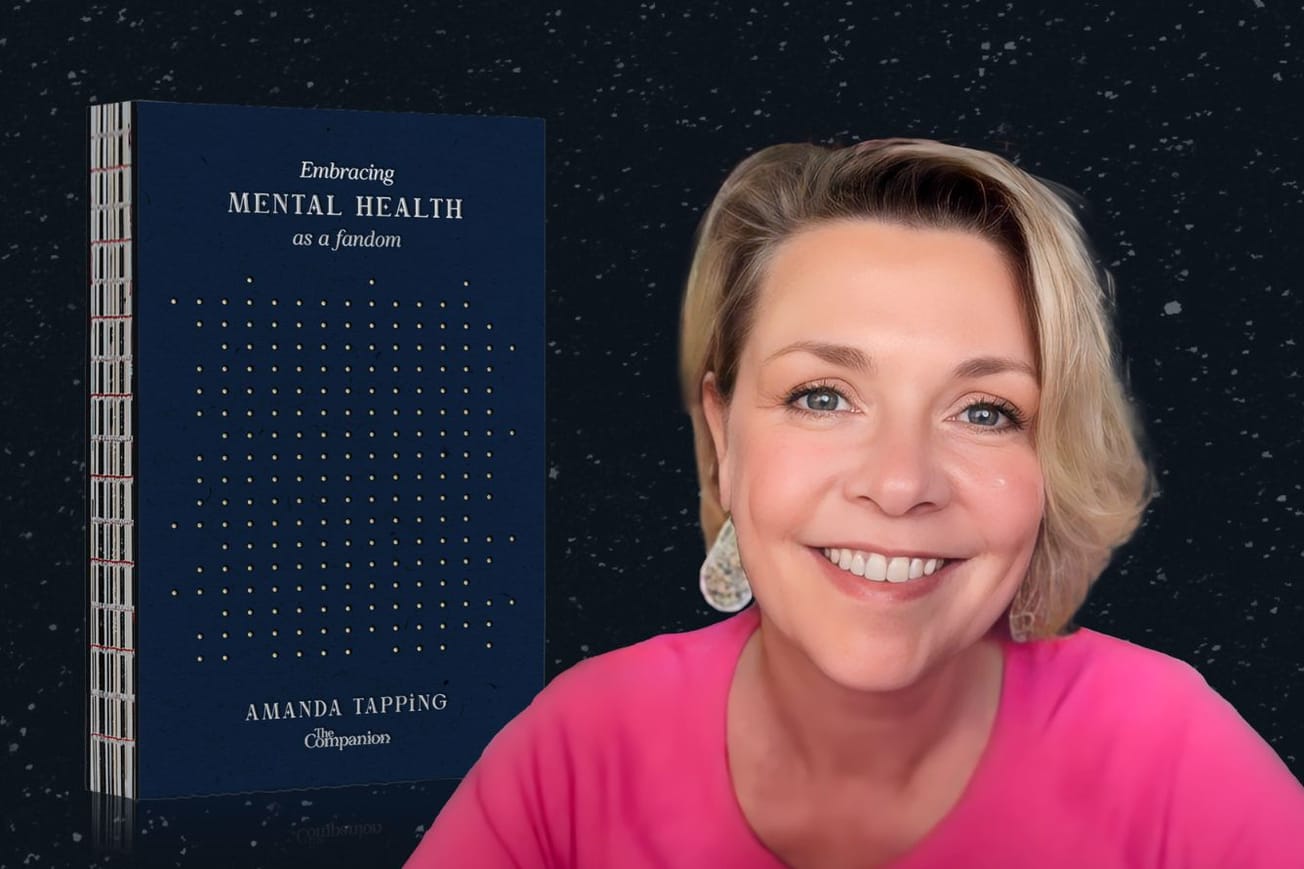On July 27th, 1997, the pilot episode of Stargate SG-1 aired on US cable network Showtime, becoming the network’s highest-rated series debut and birthing a fandom that still endures. Because we want to give you as much detail as you can handle about the greatest show ever, we’re delving into some of the most iconic episodes of the Stargate franchise.
Join us as we revisit the incredible ambition, the inspired casting, and the studio politics behind ‘Children of the Gods’.
As told by
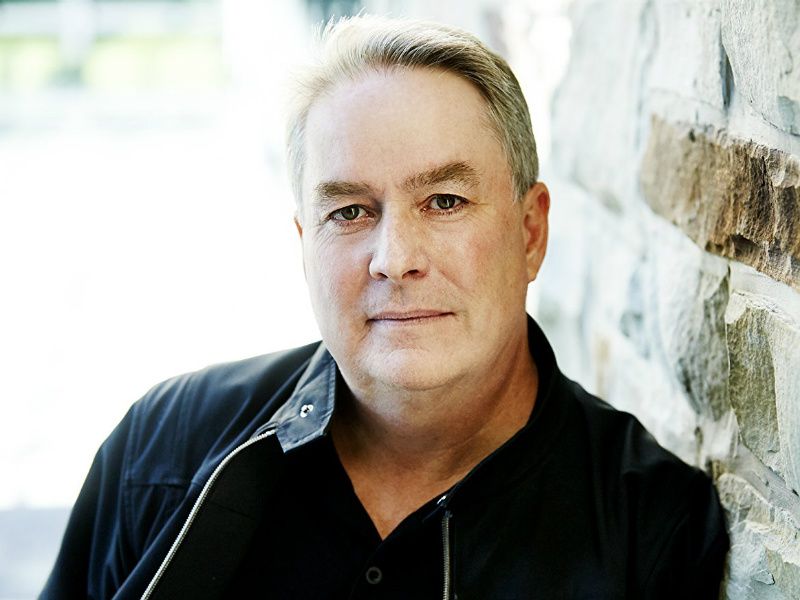
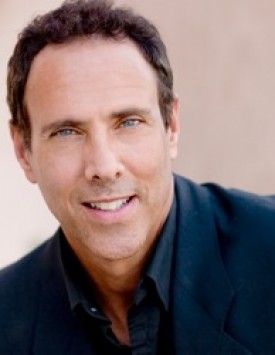
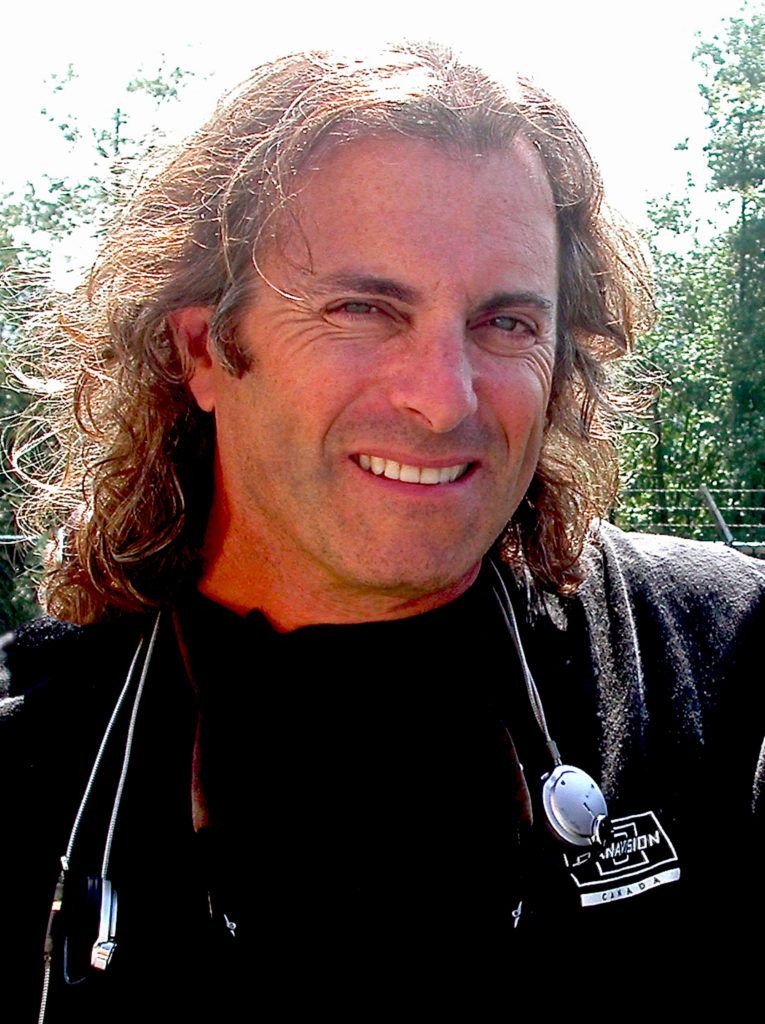
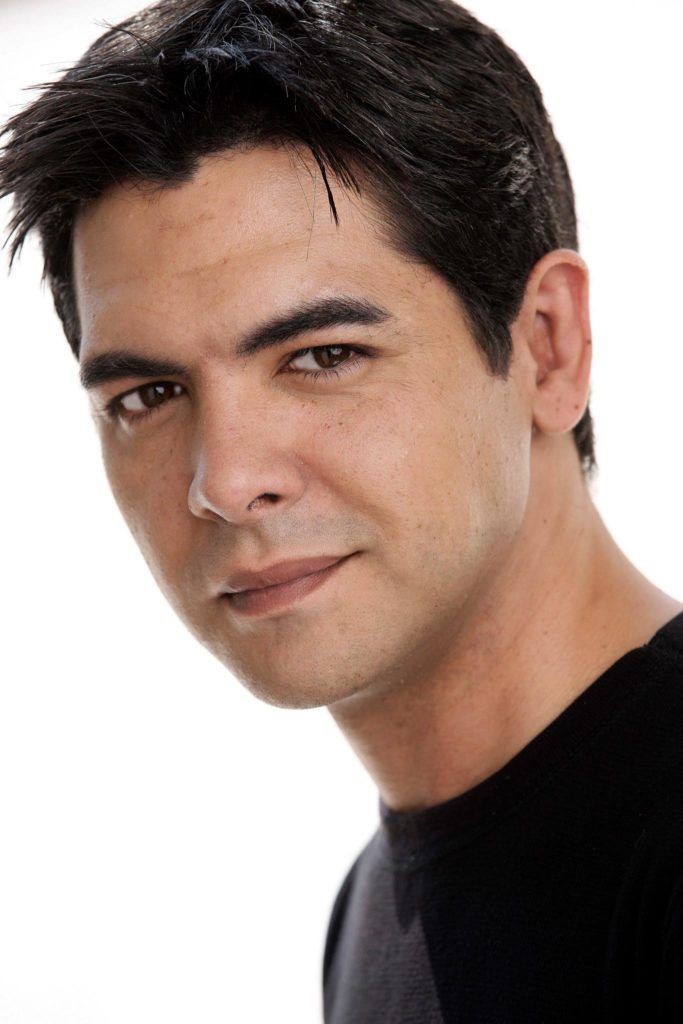
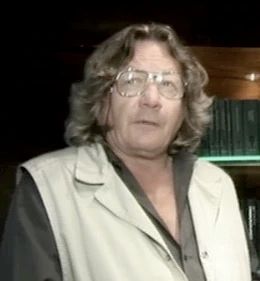
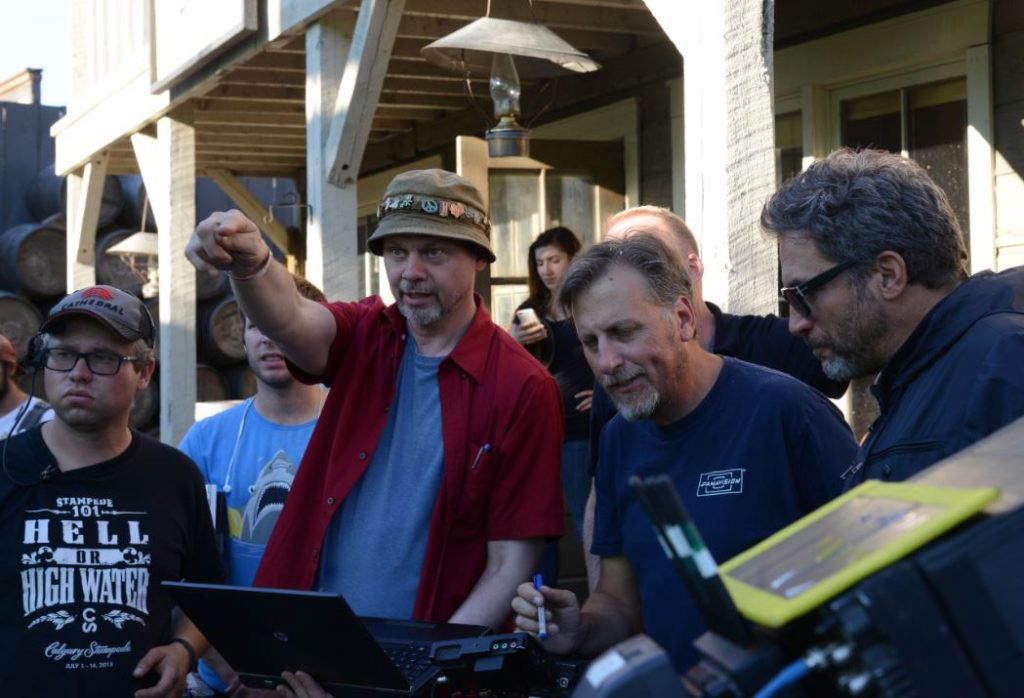
How Stargate SG-1 Began
Brad Wright (Co-Creator/Executive Producer): Jonathan [Glassner] and I were both working on The Outer Limits and having a great time.
We each independently went and saw the film Stargate and each independently realized this would be a better series than it ever was a film. And we each independently went to MGM and said, you know, this would be great. And the president, John Symes, approached us independently and said, “I think you guys should do this and I think you should be partners if you’re open to it.”
So Jon met with them first and then walked down the hall and I was next and I said, “What’s this about?” And then [Symes] said, “Do you want to partner up? But the one thing attached to it is you have to keep making The Outer Limits.”
Paul Weber (MGM Casting Director): MGM were able to figure out this syndicated world that they grabbed by the horns and were able to take this show through a second window and create this amazing juggernaut. It started with Stargate. And we were excited about it because I believe – and I might be wrong on this – on this, there was a 44-episode order.
Michael Greenburg (Richard Dean Anderson’s Production Partner/Executive Producer): We kinda knew Stargate was going to succeed, at least in number of episodes because we originally got 44 episodes which is two years with Showtime and I think we were into our third or fourth episode and they gave us another 44. So right in the first year, we had 88 episodes to do. There’s four years of your life right there.
Brad Wright: We knew we were doing 44. That is unheard of, right?
Michael Greenburg: On MacGyver, we never knew if we were coming back the next year. We’d find out each year in May. Rick and I would go away somewhere, to Tahiti or Europe, to get away, to cool down, and then we’d get a phone call saying, ‘We’re coming back!’
Brad Wright: We knew we had to build out a universe. That’s what I walked out of the movie theater with. That’s the reason we thought it would be a good series is [that] a gate with 29 symbols that you could dial like a rotary telephone clearly could go to multiple locations. I mean, why have all those symbols? It’s a pretty elaborate combination lock if it only goes to Abydos. This could be dozens if not hundreds of planets. And Ra could be one of many.
We were discussing it with John Symes he mentioned the title and said, “Well, it’s got to be Stargate something.” And Jonathan goes like, “SG-1, you know, or something like that.” Jon’s writing stuff down and he goes, “Okay, guys, I got enough for now.”
In the elevator on the way down, I said, “Jon, we can’t call it SG-1, it makes no sense!” And he goes, “Oh, we’ll think of something.” A couple of days later, front page of Variety – Stargate SG-1. I said to Jon, “I guess that’s the title of the show now!”
Casting ‘Children of the Gods’
Alexis Cruz (Skaara/Kloreal, also appeared in Roland Emmerich’s movie): I guess it was about two or three years after the film was released and my agent called me with the offer, they’re doing a Stargate television series and they want to know if you want to be involved in it. It’s a straight offer, a series regular, [with] 44 episodes on the air guaranteed. What do you say? Like, it was an unprecedented offer for anyone, much less me.
Brad Wright: I wanted to have that Right Stuff feel. I like Jack’s story. It was a redemption story. And I like the Daniel story. We just built a team around them. We thought we needed an alien and we wanted a strong woman who was military. And it started as two characters and it became one because she had to be a scientist, but she also had to be able to run. I said, “Well, there are scientists in the military,” and so that’s how Carter got born.

Paul Weber: I was brought on to help cast the show and the marching orders were not dissimilar to many of the other Canadian shows or movies that I’ve had to work on, where you would anchor it with a couple of American names. And really with Richard Dean Anderson, that was it. That’s all we really needed.
Michael Greenburg: We were finishing a quirky Western series called Legend that only went one season and I got a call from John Symes asking if Rick would be interested in starring [in Stargate]. Rick said no because he didn’t think he could do it justice.
The Kurt Russell role was really strait-laced and that’s not Rick. Symes said he can make the character whatever he wants and it’s a 44-episode guarantee. And coming off Legend, Rick said, “Okay.” We were off and running.

Brad Wright: [John Symes] had suggested Rick for a role in an Outer Limits that I had written and I said no. So John didn’t think I was going to be excited about RDA for O’Neill. But he was perfect. A) He was a major television star who would bring eyeballs to the show, but B), he had a natural sense of humor that we wanted O’Neill to have going forward. There were just glimmers of it in the feature character. But in the feature, he’s going on a suicide mission because his son has just died after finding his gun. I mean, he’s in an almost irredeemable situation at the beginning of the film. It flavored that entire performance. And there was just a glimmer at the end of the film of humor and of hope. And that was the Jack O’Neill that should have continued.
And so when he suggested Rick, we said absolutely. But Rick was way, way bigger than we are, so it was more about Rick approving us once we were open to it. And there were aspects of the script that he was attracted to. I remember him pointing to the line that I had written in the script, where Teal’c says, “I have nowhere to go.” And O’Neill says, “For this, you can stay at my place.” He said, “That’s the guy. That line right there.” So we hit it off.
Alexis Cruz: I realized that if maybe some of these other television shows had had the original stars of the movie, then maybe that series would have done better because it would have established continuity for the audience. And that continuity creates legitimacy in our minds. I don’t know that people are sitting in front of it consciously, but it’s working underneath, you know, as we take our impressions of a thing that we’re watching. So I’m like, wait a minute. This is a golden opportunity for me because I can serve as that bridge. And whether it succeeds or fails, I’m going to get something out of it.
Paul Weber: We knew this would be a Vancouver-based show. And this show is part of that growth for the industry there. What we did is sort of scour the Canadian landscape with Betty Chadwick and her team, who was the Canadian casting director and who we owe a lot to, because they had to get down in the trenches and really dig for actors that we thought would have lasting power.

Brad Wright: Amanda [Tapping] was my choice off the tape. And I was rooting for her from the get-go when we got to the final auditions. It was between her and someone else and I remember saying to her, “Keep doing what you’re doing. And when you’re chatting with Rick between scenes, you’re funny and you’re engaging – bring some of that into the character because what we’ve written you on the page is kind of boring. You need to help us.” And that’s what all good actors do, right?
Paul Weber: I remember there was a final casting session. And one of our executives had watched two actors audition, two top contenders for one of the series regulars. And after they left the room, they were both excellent. This would be career-changing for one of them.
None of them were very well-known at the time and we were all split about it. And I remember that executive when we asked him, “Well, who do you think? Which one?”, he said, “They’re both great. Let’s go with the blonde one.” You know, I’m not sure if you can say that. But sometimes it just comes down to the blonde or brunette. They’re both equal talents.
Alexis Cruz: I knew the show was going to succeed. It was sort of a no-brainer to me. But I’d be up there for four, five years and I had no guarantee that my character wouldn’t have stayed some form of sidekick. And I had no way of communicating my concerns or having my concerns, you know, folded into the work. I didn’t have any guarantee of that aside from a word and a smile.

Alexis Cruz: What I brought back was, “Yeah, I’m down. But here’s what I do want to do, is let’s keep it special and have me do recurring.” And you know, most actors never stepped down from regular to recurring, but I was looking for mobility. I say, “Let me do recurring on this. Season openers, season enders, that very special episode, whatever it is.” Because I knew that they’re not going to want to do the Abydos storyline forever. And I don’t want to do the sidekick forever. So we’ll do it that way and then it’s special for both of us. And watch the ratings skyrocket every time that happens.
Brad Wright: Teal’cs were harder to find. It’s more like you had to meet the person because the physical presence was so important. You don’t really get that on the casting tape, right? So Christopher walked in the room looking like a chiseled Black god with his shoulders, you know, wider than the chair that he was sitting in. And Rick is very good at breaking the tension by saying something funny off the top.
Chris walks in and Rick goes, “Dude, why don’t you hit the gym? Don’t you even care?” And it made Christopher laugh pretty hard. And then he dropped it all again for his Teal’c persona, which was kind of funny and made me laugh.
Paul Weber: We were kind of going all over the place on that role. We needed someone visual in the same way that we needed someone visual for Stargate Atlantis with the Jason Momoa character. It was the same with Christopher Judge, who had even less experience. So it was quite a throw of the dice there with him. We wanted someone who was extremely visually unusual and alienesque. And I think for the show that was really important, just like it was for many of the guest stars, the off-world guest stars, we had to have actors who had presence, who could compete with the scenery. Many of them were classically trained actors, which was fine for me because those are the actors I like to find and work with, the ones who have great stage presence because they understand the mythical nature of the piece. And it can’t be a small box actor, it can’t be a CSI actor. It has to be someone who can really take the language that they wrote for these characters. So [with Christopher] I think the team really found someone that they felt that they could work with, grow with, and write for.

Brad Wright: Michael Shanks was so young. He was 26 and he was supposed to be Dr. Daniel Jackson. And that was the big pushback. I’m the only one who remembers it this way, but we went around the room and everybody said the other guy’s name and they got to me and I said, “Michael Shanks, sorry.” And so he had to come back the next day. Had it been unanimous the other way, it would have been somebody else. It would have gone to the other guy.
The next day, we were totally in agreement that he was the guy because we gave them a new scene. And Michael brought that great quick energy to the character that really helped balance the team.
Michael Greenburg: Don Davis we had a relationship with on MacGyver. He was actually [series star] Dana Elcar’s stunt double, so he knew me and Rick quite well because we shot four years of MacGyver in Vancouver and that’s where we met Don. He was our choice for the General.
Paul Weber: I think it’s a testament to all those actors that they survived as long as they wanted to on the show. I think there was a big sigh of relief from all of us. You can’t afford to get it wrong when you’ve ordered 44 episodes. That’s the difference between a pilot and going straight to series. That’s where the pressure was on casting. Are we going to be able to find actors that we’re going to live with for a long time and have in the family? I think we were all quite satisfied that we were able to do that.
Starting Work on ‘Children of the Gods’
Brad Wright: Launching a new show is extremely time-consuming and difficult while you’re doing it. If you’re also producing an anthology show full-time, it’s crazy. But we said yes and we did it. And I honestly think Stargate suffered for it because, you know, you would do a pass on the Stargate script and then go, “Oh, shit, I have to go do my other job.”
Michael Greenburg: It’s a pretty formidable series. There are a ton of departments.
Richard Hudolin (Production Designer): I flew out to LA where MGM had stored whatever they could from the movie. There were bits and pieces of the Stargate ring, which I had shipped up to Vancouver. I could pull molds off that, which saved some work. They’d saved a number of things, but there was nothing intact, like a full set or anything. But I had enough bits and pieces to fill three trailers and from those, we were able to build other things.
John Gajdecki (Visual Effects Supervisor): When we started, one of the things they brought us – and God, I don’t know how they found it – was one of the original pyramid models from the movie.
Michael Greenburg: We had massive storyboards and it was very challenging, difficult, yet very rewarding. We got to pioneer so many things. We were an Air Force-sanctioned show, so we had to do things by the book. We were the first to use the P90, it’s a rapid-fire machine gun. But we had a great armorer and he was so on it.

Brad Wright: John was generous with the series order but the per-episode budget was not enough. I was raising my flag from the beginning. We got a significant chunk of change to do the pilot and then we went way over budget on the pilot, not just because that’s what all pilots do, but because we kind of got the shit beat out of us with the weather.
We were trying to shoot in the mountains in February, you know, in those costumes. And it was very difficult. None of Christopher’s first day was usable because his lip was quivering from the cold. And we lost a whole film roll of Michael Shanks’ coverage because of a scratch down the middle on day one.
Alexis Cruz: The first one was a little weird because when I got there we were in this foggy, rainy forest in Canada. And I’m like, I don’t understand this. But everybody on set was welcoming. They were polite, so respectful, [and] warm. I made really close friendships with a lot of people and that’s not always easy for me. But they’ve lasted, you know.
Building the Look of Stargate SG-1
Richard Hudolin: There were a couple of big standing sets. We had to redesign the Stargate to work for television. Because that Gate has to work every week, a number of times. When the original Gate is built, it’s basically a one-time use. I saw the original Gate and it was basically just a cast. It could have been CG in how they turned it.
In our case, they wanted the lights to light up, and then it had to spin. So we had a gear built, it was a 20-foot diameter gear which is a custom build. It was huge, even to transport it.

Brad Wright: The biggest problem we had facing us was that the building, the stage they were physically building for us, for ‘Children…’, wasn’t ready. So we had to build that set, the SGC set, inside another stage, shoot the pilot, move the set and rebuild it in its stages two months later because we had to hit Showtime’s summer launch, that’s when they wanted the show and we were backing into a date.
That’s like taking money, setting it on fire and watching it burn. It’s like re-roofing your house. It looks just the same when you’re done and you’re poor.
Richard Hudolin: We were building the studio it was going to go in before the Gate actually got there. I was saying, “Jesus Christ, it’s got to go through that door, man!”’ These are little thoughts you have in the middle of the night. This is going to cost a whole lot of money if we have to rip out that wall!

Michael Greenburg: I had to manage the composite nature of Stargate which is a beast of a show to do because sometimes you’re only shooting parts of the frame.
Brad Wright: We needed to hook people with ‘Children of the Gods’ in terms of the visuals. So we rolled the dice and we spent the money and John Symes was a big fan of bottle shows, so we eventually even did one of those clip shows, yeah…
Alexis Cruz: I think they got the nature of the premise 100% correct. These characters are about us. You know, we always relate to the characters in the film, what have you, but I think the TV show really made a point of making them us, the audience, us stepping through that gate week to week to week.
Michael Greenburg: We tried to make helmets that sort of went on their own. I remember that being very difficult.
Richard Hudolin: There were costumes designed to mimic the movie, except we did it mechanical rather than CG. They were tricky as hell to make. But they used them a number of times.
Alexis Cruz: The constraints of television versus film? Massive difference. It’s a shorter period of time from beginning to end on a film. But there’s a lot more detail in everything.

Brad Wright: One thing that had to look as good as the movie was the Stargate and the puddle. We added the colored chevrons because this is TV. Everybody’s screens are 20 inches wide, which they were at the time. And it was standard def, right? The resolution is nowhere near what the film was or what today’s television is. I suggested the colored chevrons to differentiate us from the film.
And our puddle – we called it the kawoosh when it opens – our Canadian visual effects supervisor reproduced their kawoosh effect and their puddle image by basically copying their methodology. It was so time-consuming. For one person to walk through the puddle, an active puddle, just one person, $5,000, two people $10,000. In 2011, when we shot our last shot of the puddle in Stargate Universe, one person going through the puddle? Still $5,000.

John Gajdecki: I remember watching the film, and being amazed by the visual effects – you know, that’s kind of my shtick. And just looking at what they did and seeing the… what we ended up calling the kawoosh when the water came out and the Gate activated, that was really something. How did they do that? It looks so real. But it has to be CG, because everything is CG. And as we did the research, of course, it wasn’t [CG] – they shot it in a big water tank. And we did ours exactly the same way.
We set the pressure to, uh, probably like 50 pounds. So, we roll the camera at 120 frames per second, and the water is as flat as we can make it, you push the button and it just lets the air go down a tube right into the water. Well, as it turns out they used about 5lbs or 10lbs [in the film] so 50lbs just emptied the tank everywhere!

Richard Hudolin: There were two Stargates. There was one in the studio and then there was the mobile one we had to take to locations all the time. The location one had to come apart because you couldn’t truck a 20-foot diameter ring very easily. It would be set up every time we went somewhere.
John Gajdecki: This was a set piece that traveled, and it couldn’t spin. I don’t even know if it lit up.
Alexis Cruz: I hated the dreads! Oh, my God. I couldn’t stand them. I got this big, heavy rolled-up wig, which was for Klorel. And that all made sense. It was very much Klorel taking this body that he’s conquered and making it his own.
But in real life, technically, it was heavy and uncomfortable, whereas the locks that I had in the film were real in that they were my hair with extensions. I just used it in that Klorel’s uncomfortable in this body. And so that itchiness and the weight in the head became emblematic of that.
Telling the Story of ‘Children of the Gods’
Michael Greenburg: I remember the nudity scenes getting a lot of discussion and attention. You don’t want to be gratuitous, but I think Brad and Jonathan really fought for it because it was sort of a necessity. It would have been weird to cover up. There was a lot of pro and con discussion after it.
It just wasn’t the spirit of the show we were actually making. They said go ahead and put nudity in it because it’s Showtime. And so we kind of wrote it in, but I was like, “This isn’t the show we’re going to go on to make.” I think it’s one of the reasons that we weren’t very well-received critically.
Brad Wright: I think the biggest feather in our cap was People magazine gave us a B, which we were pretty excited about. But it was because there was this disconnect between the show we were making, which was fun, sardonic humor, and run and jump, with full-frontal nudity thrown in. Yes, that was the plot and I had a lot to do with the creation of the plot. But it didn’t have to be so in your face. So that was my that was pretty much my biggest problem with [the pilot] – that and some of the dialogue.

Alexis Cruz: I had no idea what they were going to do with the story. What was completely unexpected was Klorel. They pick me up from the airport in Vancouver to go to my hotel and in the van, I get my [script]. And I was like, mind blown. Nervous and concerned and scared – like, what am I going to do with this?
Because what nobody really understood at the time was that I had a very deliberate, thought-out, meticulous characterization for Skaara. This was the tale of a hero. So that got uprooted. And I didn’t know what to do with that. And there was a moment where it stung. I had to figure out, “So what happens now?”
Reflecting on ‘Children of the Gods’ 25 Years Later
Richard Hudolin: They were all cool guys, [and] fun to be around. You left your ego in the parking lot and then went to work.
Michael Greenburg: The biggest takeaway was just how challenging, but how rewarding each day was because of all the departments involved. Production and post-production, combining the whole thing.
Brad Wright: It was a very stressful couple of years. I mean, everybody is very fond of ‘Children of the Gods’ in retrospect, [but] I wasn’t crazy about it, even then. I had notes on my own script. Then Joel Goldsmith had written this gorgeous score that was a bit Stargate-y in my mind, but it didn’t completely honor the original theme. And John Symes said, “We own the theme, why isn’t the theme wall-to-wall on the show?” The aired pilot score is a mishmash of Joel’s score and David Arnold’s score [from the film], which is a great score. But the fusion was just to me, so much noise, so loud and so arbitrarily shifting back and forth in the mix.
And we were bringing up things like, none of our leads are in the tease. This is not good. It’s, you know, this strange attack of the strange thing with actors who are all killed.
Paul Weber: These were big breaks for these actors, we needed to feel like there’s a certain humility because it was an ensemble. And some actors can’t handle the technical language required. Are they compelling, intelligent characters, people, [or] actors? Are they able to embrace that effortlessly? And not every actor can do that. They’re just not tuned for it.
You know, Richard Dean was the anchor and everyone respected Richard Dean as that star and anchor. The rest were all supporting leads. And I think maybe that was the secret sauce of the creative team, that they were able to maintain that status, giving all the actors opportunities, but realizing that they’re part of an ensemble.
Alexis Cruz: [TV spin-offs of movies] don’t always translate well. I think in general, the trend in the past has been, you know, there’s an intention to do service to it. But oftentimes it’s just glossed over and people are writing a brand. Let’s just make a television series and slap it with this license. [But in the case of Stargate SG-1] it’s iconic. And it’s a blessing to have been called on at that moment in time. To serve those forces.
This article was first published on July 13th, 2022, on the original Companion website.
The cost of your membership has allowed us to mentor new writers and allowed us to reflect the diversity of voices within fandom. None of this is possible without you. Thank you. 🙂


